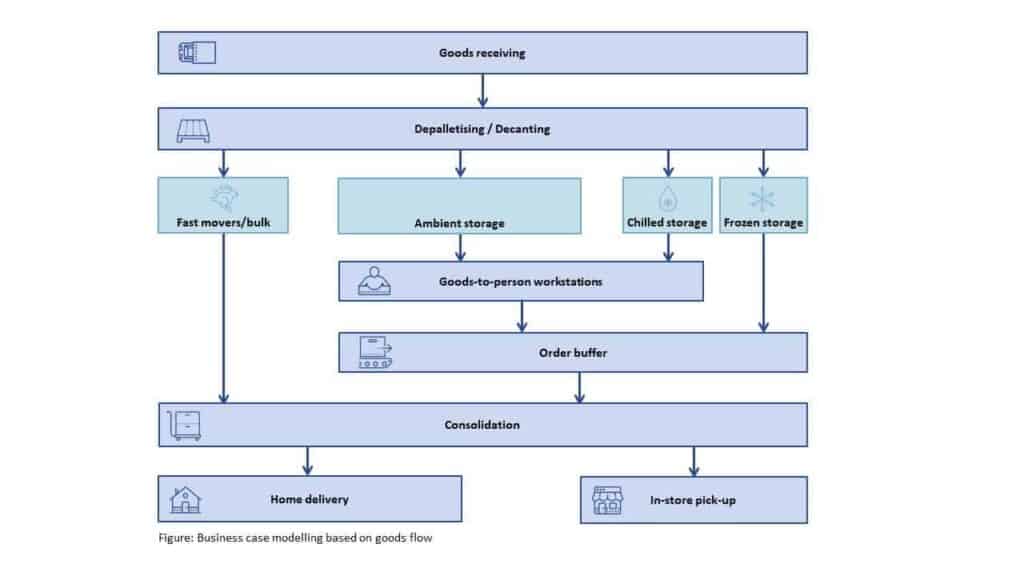Every company and every market is different. This is reflected in the layout of your warehouse. Our warehousing experts are available to offer tailor-made advice.
Despite the increasing challenges of dealing with rising labour scarcity and the cost of manual operations, food retailers will always discuss if there is a solid case for automating part (or all) of their operations. We know that this is one of the hardest sectors in which to turn a profit, because the low margins barely cover the additional costs for picking and transport. Therefore, the total cost of ownership (TCO), consisting of both the capital expenditure (CAPEX) and the operational expenditure (OPEX), is one of the main KPIs for food retailers to base their investment decision on.
As our customers are having to react fast to constantly shifting consumer habits, they are interested to explore exactly what level of warehouse automation could be beneficial for them. At Vanderlande, one of the best ways to demonstrate this is by making a business case analysis, together with our customer.
Building up the business case
The business case is much more than just a tool that we present to a customer. We see it as a critical starting point to derive exactly what is needed to create the best solution. It needs to answer important questions such as: what level of automation has the quickest payback; how you financially compare systems with different technologies; what are the costs per item or order line; and what is the total cost of ownership?
How does it work? Generally, we start by working with our customer to acquire current business input data, such as throughput, labour rate and space costs. This is followed by financial costs, for example capital costs, and process input, such as the number of SKUs, orders per day and average items per order.
Then we follow the goods flow and accumulate the data from such processes as goods receiving, storage, order picking, consolidation and shipping. Productivities can be expressed as picked lines per operator per hour and then calculated as the required manhours, space etc, per process step. Together with the customer, we can define and compare the productivities per process step as well as the complete operation.

The business case always triggers many interesting questions and helps to identify not only where opportunities lie, but also where balances need to be made. With the right insights, we can make a more accurate estimation what the quantified business value is of the investment in an automated solution.
Understanding the results
When presenting the results, we usually benchmark several options, including current manual processes. We compare them in terms of capital and operational investment, productivity, and payback period. Parameters that can have a high impact on the business case include operational hours and the number of shifts and hours worked per day. Obviously, installing a system that is operational for 20 hours a day will give a much better return on investment than one that is standing still for half the day.
Comparing and contrasting
Fully understanding the labour costs, throughput and productivity levels of a customer’s current way of working allows us to assess different technologies and advise whether and what level of automation is advisable.
If labour rates and real estate costs are high, a solution that offers high storage density using the available building height makes economic sense. And as the business case gives us a rate for each process step (eg picking) we can play with all of the different parameters to determine what the actual tipping point for automation will be in view of rising costs of labour.
If throughput is not that high or when available building height is limited, a manual or semi-automated system may still be the preferred option. The fact that labour scarcity is becoming a bigger problem in many regions however will give certain risks for these operational models in the future.
Speed is of the essence
Who could have envisaged the changes that have already taken place in the food retail landscape, especially in the past couple of years? Concepts like ‘same day’ or ‘instant’ delivery are now standard, and we could never have foreseen that, other than maybe as a premium type of service. With the pace of change seen in food e-com, the need to make more informed decisions faster becomes more critical and our business case analysis can help out.
In these uncertain times, the only certainty is that the food e-com market will continue to evolve rapidly, but rest assured that as a reliable and trusted systems integrator, Vanderlande is well prepared for different operational models and is looking to partner with those considering automation to make their fulfilment processes future proof. With our business case approach, we can help make decisions together about the most effective way forward.